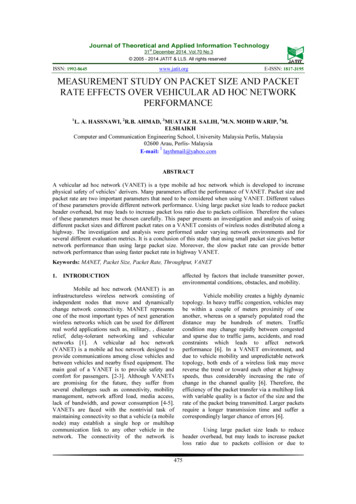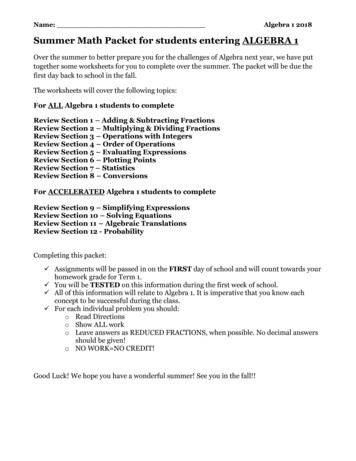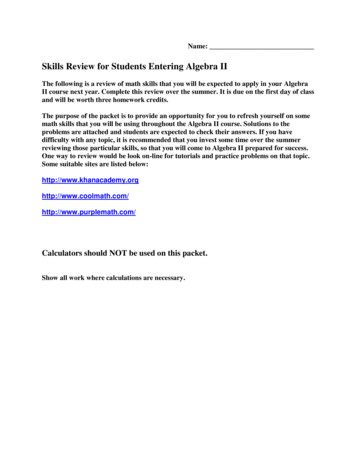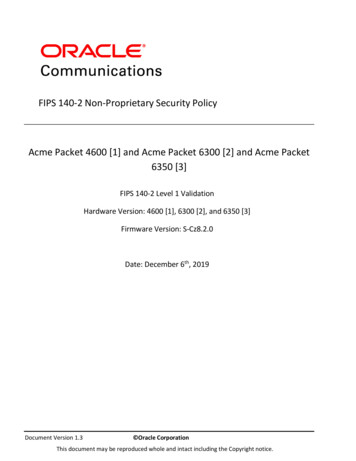
Transcription
June 2012Dear Geometry Students and Parents:Welcome to Geometry! For the 2012-2013 school year, we would like to focus your attention to the fact that manyconcepts from Algebra I are infused into Geometry. In order to be successful in Geometry, a student mustdemonstrate a proficiency in certain skills including: Multiplying PolynomialsFactoringSolving Systems of EquationsDetermining the Equations of Lines Parallel Lines Perpendicular LinesSimplifying RadicalsThese topics will be reviewed briefly throughout the coming year; however, the topics are not re-taught in theGeometry course. To ensure that all students demonstrate the basic algebra skills to be successful, an assessmentwill be administered within the first two weeks of school (date to be determined). The attached review packet isprovided for practice and is intended as a tool for assessment readiness. A one-day, full class period review will beconducted in each class. In addition, students are encouraged to seek extra help before or after school from theirteacher for any topics requiring more personal in-depth remediation. Additional practice problems and explanationsmay also be found beginning on page 869 of the Geometry textbook.It is expected that each student will fully complete the review packet. Packets will be collected in class on the day ofthe assessment. If you have any questions, please do not hesitate to contact your child’s teacher.Mr. HymanMs. JewettMs. KastMs. MarchegianoMs. RiggiMrs. PoynerMs. ShulmanMr. WaddonAlgebra 1 Review PacketPage 1
Binomial ProductsTo multiply two binomials, you can use the Distributive Property systematically. Youmay know this as the “FOIL” method or “Area Model”.Example: Find the productSimplify combine like termsSimplify ()()(())()Rewrite as the product of the binomial and itself()()()() DistributeSimplify--multiplySimplify--combine like termsSimplify1) (2) (3) ()))Algebra 1 Review PacketPage 2
FactoringFactoring (Common Monomial Factor)Solution: The first step in ANY factoring problem is to factor out the GCF. The other factoris the original polynomial divided by the GCF.A variable must be in each term of the polynomial in order to be in the GCF.Always use the smallest exponent in the GCF.If there is no common factor, the polynomial can be “prime.”Example: Factor completely 24 xy 18xy 2 3 y24 xy 18xy 2 3 yInitial polynomialGCF 3 yFind the GCF24 xy 18 xy 2 3 y 8 x 6 xy 13yDetermine other factor bydividing each term by theGCF3 y(8x 6 xy 1)Final factorizationLook to see if the polynomialfactors further.Factor Completely4) 3 y 2 9 y5) 54 x 5 y 3 z 2 9 x 2 y 6 r 3 36 x 4 r 76) 5x 2 y 2 9r 3 7 zAlgebra 1 Review PacketPage 3
Factoring (trinomial where a 1 )Solution: Put expression into standard form, if not already done.Standard form: ax 2 bx cIf necessary, factor out the GCF or a “ 1” (if the a is negative). Then look to see ifyou can factor further.Look to see if the resulting trinomial can be factored further. For any trinomial ofform x 2 bx c , it will factor if there are two factors of c that add up to b (i.e.,factors f 1 and f 2 , such that f1 f 2 c and f1 f 2 b ). The trinomial can then befactored as ( x f1 )( x f 2 ) When finding the factors f 1 and f 2 , remember that if c is negative, f 1 and f 2 musthave different signs (one positive and one negative). If c is positive, then f 1 and f 2 must both have the same sign as b.If there are no two such factors, then the trinomial is “prime.”Example: Factor completely2 x 2 20 x 422 x 2 20 x 42Standard Form, if necessary.2( x 2 10 x 21)Factor out the GCF of 2.f1 7 , f 2 3Find the factors of 21 that add upto -10.They must both be negative.2( x 7)( x 3)Use f 1 and f 2 to factor thetrinomial.*As part of the final answer, don’tforget to bring down the G.C.F.*Algebra 1 Review PacketPage 4
Factor Completely7)8)9)10)11)12)Algebra 1 Review PacketPage 5
Factoring (trinomial where a 1 )Solution:There are several methods for factoring these types of trinomials. If you prefer anothermethod, see your teacher if you have any questions.Example:Factor completely 5x 6 6 x 2Method 1: AC Method 5x 6 6 x 2Initial trinomial6 x 2 5x 6Step 1: Put into standard form, if necessarynot necessaryStep 2: Factor out GCF or 1, if necessary 6 6 36Step 3: Multiply a cf1 4 , f 2 9Step 4: Find the factors of the product ofa c that add up to b (i.e., factors f 1 and f 2 ,such that f1 f 2 a c and f1 f 2 b ).Remember that if a c is negative, f 1 and f 2must have different signs (one positive andone negative). If a c is positive, then f 1 andf 2 must both have the same sign as b. 6x 2 4x 9x 6Step 5: Rewrite the middle term as the sumof two terms whose coefficients are thenumbers above. 2 x 3x 2 3 3x 2 **Step 6: Factor by grouping 3x 2 2 x 3 **the expression in the parentheses must bethe same6 x 2 5x 6Algebra 1 Review PacketPage 6
Method 2: Slide-Divide-Slide6 x 2 5x 6Initial trinomial.not necessaryStep 1: Factor out GCF or 1, if necessary.6 x 2 5x 6Step 2: Multiply a c.(SLIDE) 6 6 36Step 3: Leading coefficient becomes 1 and cis replaced with a c .**if this trinomial is not factorable, then theoriginal trinomial is primef1 4 , f 2 9()(Step 4: Find the factors ofto)Step 5: Usethat add upto factor the trinomial.()()Step 6: DIVIDE()()Step 7: Simplify fractions, if necessary.()()Algebra 1 Review Packetby “a”.Step 8: SLIDE denominators of each factorto become the coefficient of .Page 7
Factor completely using the method of your choice.13)2 x2 11x 514)8x2 6 x 915) 8x2 6 x 2Algebra 1 Review PacketPage 8
Factoring (binomial)Solution: a 2 b 2 (a b)(a b)“Difference of Two Perfect Squares” Must be a binomial (two terms) Terms must be subtracted Each term must be a perfect square**A binomial with the sum of two perfect squares is prime.Example:Factor completely81x 2 1681x 2 16Original binomialnot necessaryFactor out G.C.F. or 1, ifnecessary81x 2 16Are the terms subtracted? YES!81x 2 (9 x) 2Are the first and last terms perfectsquares? YES!16 (4) 281x 2 16 (9 x 4)(9 x 4)Answer is the product of the sumand difference of the square roots.Factor completely16)25x 2 117) 100 36 y 218) 64 y 4 49 x 6Algebra 1 Review PacketPage 9
Solving Quadratics by FactoringSolution: Re-write the quadratic in standard form ax 2 bx c 0 .Factor the polynomial completelySet each factor equal to zero (use “or” between the equations)Solve each resulting equation to obtain two solutions.Example: Solve 6 x 2 5x 66 x 2 5x 6Original equation6 x 2 5x 6 0Write in standard form(2 x 3)(3x 2) 0Factor the polynomial completely2 x 3 0 or 3x 2 0Set each factor equal to zerox 32orx 23Solve both equationsTip: If you have a negative sign in front of the x 2 term, simply multiply both sides of theequation by -1, then go ahead and factor. Similarly, divide both sides by any GCF. Forexample, change 18x2 15x 18 0 to 6 x 2 5x 6 0 by dividing both sides by -3.Solve19) 16 x 2 10 x21)24 x 2 10 x 6 0Algebra 1 Review Packet20) 2 x 2 70 4 xPage 10
GraphingDetermine and graph the equation of a lineSolution:. Determine slope from the two given points using the formula Determine the y-intercept (b) by using substitute a point for the x and y variables substitute the slope for the m variable solve for bRewrite the equationby replacing the m and b variables with the valuesyou found.Use the slope and y-intercept to graph. Example: Determine and graph the equation of the line passing through the points ().and ((())( )( ))Determine slopeDetermine the y-intercept—you may use either pointWrite the equationGraph on the next pageAlgebra 1 Review PacketGraph equation using y-intercept and slopePage 11
y-interceptat 131Determine and graph the equation of the line passing through the given point22) ()()Algebra 1 Review PacketPage 12
23) (24) ()())(Algebra 1 Review Packet)Page 13
Determine the equation of a line parallel or perpendicular to another line.Example: Determine the equation of a line in slope-intercept form which isperpendicular/parallel to the line 2 x 3 y 8 and passes through the point 1, 5 .Solution:Step 1: Determine the slope of the given equation by writing in slope-intercept form.2x 3y 8The slope is 3 y 2 x 8y 28x 33Step 2: Determine the slope of the perpendicular line and parallel line3m 2The slopes of perpendicular linesare opposite reciprocals The slopes of parallel linesare equalStep 3: Using the slope from step 2 and the given point, determine the y-intercept (b).PerpendicularParallely mx by mx b 3 5 1 b 2 35 b27 b2 2 5 1 b 3 25 b317 b3Step 4: Write the equation of the line by substituting your values for m and b.PerpendicularParallel37y x 22y Algebra 1 Review Packet217x 33Page 14
25) Determine the equation of a line in slope-intercept form which is perpendicular tothe line x 4 y 8 and passes through the point 2, 6 .26) Determine the equation of a line in slope-intercept form which is parallel to the line 4 x 3 y 1 and passes through the point 3, 3 .27) Determine the equation of a line in slope-intercept form which is perpendicular tothe line 4 x 2 y 8 and passes through the point 1, 6 .Algebra 1 Review PacketPage 15
System of EquationsSolution:There are three ways to solve a system of equations:1. Graphing Method2. Substitution Method3. Elimination MethodWe will demonstrate the substitution and elimination methods.Example: Consider the system of equations: {Substitution method:Step 1: Solve for one variable in one of the equations.Step 2: Substitute the expression into the OTHER equation.Step 3: Solve your new equation.Step 4: Substitute the value of variable into one of the original equations to determinesecond variable.Step 5: Write your answer as an ordered pair.Step 1: Solve for onevariable()SubstituteSubstituteSolution: (Algebra 1 Review Packet)Page 16
Elimination Method:Step 1: Line up the variables on one side and the constants on the other side.Step 2: Determine a variable you want to eliminate—you want the coefficients to be thesame number with opposite signs.Step 2: If necessary, multiply one or both equations by a number to force thecoefficients to be the same number with opposite signs.Step 3: Add the equations together so that one variable cancels out.Step 4: Solve the equation.Step 5: Substitute the value of variable into one of the original equations to determinethe value of the second variableStep 5: Write your answer as an ordered pair.Eliminate the x variable bymultiplying the second equationby 2{() ()SubstituteSolution: (Algebra 1 Review Packet)Page 17
Solve the following system of equations by substitution.28) {29) {Solve the following system of equations by elimination.30) {Algebra 1 Review Packet31) {Page 18
RadicalsRadicalSimplify Radicals Solutions: You will need to know all your perfect squares To simplifythrough. - -square root of perfect square -Examples: Simplify the following1. 2) 4)3) non-real answer Algebra 1 Review PacketPage 19
Add/Subtract RadicalsSolution: In order to add or subtract radicals, the index and the radicand must be the same! You combine radicals as if you were combining like-terms—add/subtract theircoefficients ONLY. Sometimes it may be necessary to simplify the radicals before you add or subtract.Examples: Simplify. Express your answer in simplified radical form.1) 2) 3) Algebra 1 Review PacketPage 20
Multiplication/Division of RadicalsSolution: **This is NOT the only way to simplify these problems** Simplify the radical first.For multiplication: Multiply numbers outside the radical together Multiply numbers under the radical together Make sure to check if your radical needs to be simplified againFor division: Divide numbers outside the radical Divide numbers under the radical Make sure to check if your radical needs to be simplified again Examples: Simplify. Express your answer in simplified radical form.1) 2) 3) ( ) ( )( )( ) Don’t forget tosimplify theradical Algebra 1 Review PacketPage 21
Simplify. Express your answer in simplified radical form.32)33) 34) 36) Algebra 1 Review Packet35)37) Page 22
Algebra 1 Review Packet Answer Sheet1)2)3)4)()(5))6) prime7) ()(8) ()(9) ()()))10) prime11)()(12) – ())()13) ()()14) ()()(15)16) (17))()(()())) or()()18) prime19)20)21)Algebra 1 Review PacketPage 23
22)23)Algebra 1 Review PacketPage 24
24)25)26)27)28) ()29) ()30)31)or No Solution()32)33) 34)35) 36) 37) Algebra 1 Review PacketPage 25
Algebra 1 Review Packet Page 3 Factoring Factoring (Common Monomial Factor) Solution: The first step in ANY factoring problem is to factor out the GCF. The other factor is the original polynomial divided by the GCF. A variable must be in each term of the polynomial in order to be in the GCF. Always use the smallest exponent in the GCF.











